新托福听力精讲+翻译
- 格式:docx
- 大小:46.13 KB
- 文档页数:11
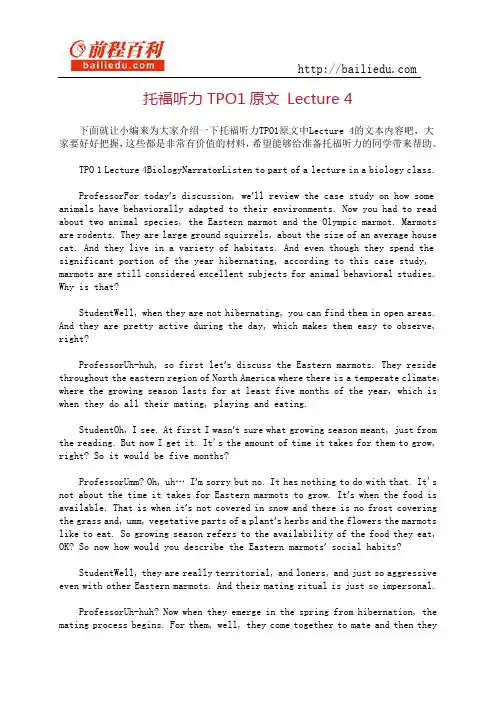
下面就让小编来为大家介绍一下托福听力TPO1原文中Lecture 4的文本内容吧,大家要好好把握,这些都是非常有价值的材料,希望能够给准备托福听力的同学带来帮助。
TPO 1 Lecture 4BiologyNarratorListen to part of a lecture in a biology class.ProfessorFor today’s discussion, we’ll review the case study on how some animals have behaviorally adapted to their environments. Now you had to read about two animal species, the Eastern marmot and the Olympic marmot. Marmots are rodents. They are large ground squirrels, about the size of an average house cat. And they live in a variety of habitats. And even though they spend the significant portion of the year hibernating, according to this case study, marmots are still considered excellent subjects for animal behavioral studies. Why is that?StudentWell, when they are not hibernating, you can find them in open areas. And they are pretty active during the day, which makes them easy to observe, right?ProfessorUh-huh, so first let’s discuss the Eastern marmots. They reside throughout the eastern region of North America where there is a temperate climate, where the growing season lasts for at least five months of the year, which is when they do all their mating, playing and eating.StudentOh, I see. At first I wasn’t sure what growing season meant, just from the reading. But now I get it. It's the amount of time it takes for them to grow, right? So it would be five months?ProfessorUmm? Oh, uh… I’m sorry but no. It has nothing to do with that. It's not about the time it takes for Eastern marmots to grow. It’s when the food is available. That is when it’s not covered in snow and there is no frost covering the grass and, umm, vegetative parts of a plant’s herbs and the flowers the marmots like to eat. So growing season refers to the availability of the food they eat, OK? So now how would you describe the Eastern marmots’ social habits?StudentWell, they are really territorial, and loners, and just so aggressive even with other Eastern marmots. And their mating ritual is just so impersonal.ProfessorUh-huh? Now when they emerge in the spring from hibernation, the mating process begins. For them, well, they come together to mate and then theygo their separate ways. Then about six to eight weeks after birth, the offspring leave their mothers.StudentReally? Just six weeks? Is that possible for the offspring to make it on their own so young?ProfessorWell, it’s not as if they aren’t ready for the real world because they are. Remember, they mature quickly and the weather’s nice. Also they live in open fields where there is lots of edible vegetation. So roughly six weeks after birth, Eastern marmots are just old enough to take their chances of surviving in the temperate environment. So how does this relate to their behavior?StudentOh, I get it. Since the climate’s not too bad, the Eastern marmots don't have to rely on each other too much and they really don't need to stay together as a family to survive either.ProfessorUh-ha. Any contrast, the Olympic marmots? What about them?StudentWell, they live together as a family and take care of their young until they are at least two years old. They’re really friendly with each other. And what I really like is that they even have greeting ceremonies. And they are not at all aggressive and territorial like the Eastern marmots. So their social behavior is so different from Eastern marmots because of the climate where they live? That seems so bizarre.ProfessorWell, the Olympic marmots inhabit meadows high in the Olympic Mountains where the weather conditions are much harsher. So there is a lot more wind and snow. The growing season only lasts about two to three months. So in that much shorter period of time, all the Olympic marmots, male and female, eat, play, work and nurture the young together. Because the climate is so harsh, cooperation increases the survival rate of the Olympic marmots. They keep their young at home until they are physically able to survive on their own. This could explain why the social behavior of the Olympic marmots is so unlike that of the Eastern marmots.翻译独白:听一段生物课的讲座教授:在开始今天的讨论前,我们先回顾一下关于一些动物的行为是如何适应他们环境的案例研究。
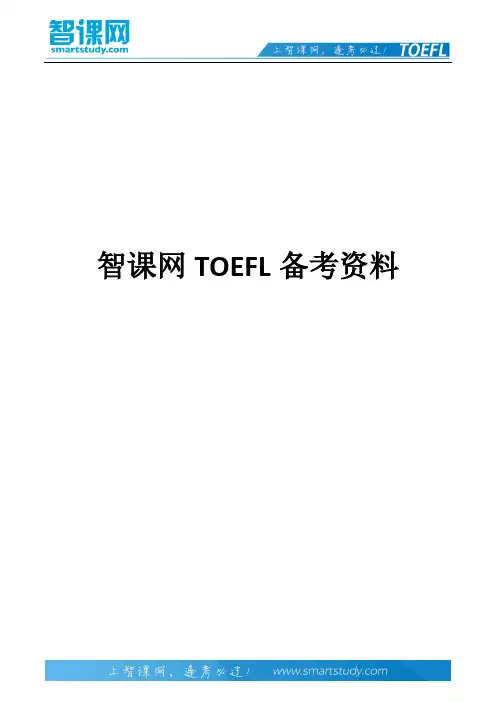
智课网TOEFL备考资料新托福听力考试对话全集摘要:新托福听力考试对话全集!新托福考试中涉及的话题繁多,同学们如大海捞针一般,并且托福听力真题资料一直很少,为帮助大家顺利备考托福听力小编特将新托福听力考试对话全部收录进来,快来看看经常有哪些话题出现在考试中。
新托福听力考试对话全集!新托福考试中涉及的话题繁多,同学们如大海捞针一般,并且托福听力真题资料一直很少,为帮助大家顺利备考托福听力小编特将新托福听力考试对话全部收录进来,快来看看经常有哪些话题出现在考试中。
1)【熔炉】(the melting pot) 备考指数:☆☆☆美国的别称。
因为美国是一个由来自世界各地不同民族的移民融合组成的国度。
这些移民说的英语不像英国人的英语那样具有较强的阶层性与地域多样性。
他们形成了相似的生活习惯与礼节;城乡居民的差别也不像其他国家的那样明显。
美国社会虽然竞争性强,且存在着种族歧视,但它在同化来自不同民族的移民方面又表现出相当大的弹性与包容性。
因而,形成了全新的整体文化与共同的民族意识,使美国成为“一个多民族组成的国家”。
美国人的人生观是基于个人奋斗、自我管束与竞争精神之上的。
针对大家托福听力提分困难的复习处境,小马有开发出模拟托福听力考场环境的托福听力APP,小马托福听力APP中涵盖了TPO1-34听力真题全部内容的,答案解析应有尽有。
为让同学们能够有条不紊的提高听力能力,小马托福听力APP开启两种模式:“修炼”、“闯关”,两大模式进行魔鬼式训练。
另外还有5000+词汇、1000+经典句子、200+文章,这么大的诱惑还等什么快来扫一扫下面的二维码下载使用吧!2)【雅皮士与雅非士】(yuppies and yuffies) ☆☆☆雅皮士是美国人根据嬉皮士(hippies)仿造的一个新词,意思是“年轻的都市专业工作者”。
雅皮士从事那些需要受过高等教育才能胜任的职业,如律师、医生、建筑师、计算机程序员、工商管理人员等。
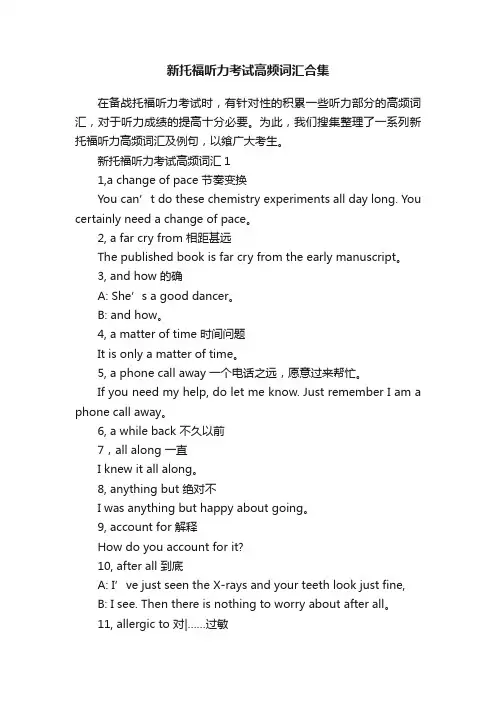
新托福听力考试高频词汇合集在备战托福听力考试时,有针对性的积累一些听力部分的高频词汇,对于听力成绩的提高十分必要。
为此,我们搜集整理了一系列新托福听力高频词汇及例句,以飨广大考生。
新托福听力考试高频词汇11,a change of pace 节奏变换You can’t do these chemistry experiments all day long. You certainly need a change of pace。
2, a far cry from 相距甚远The published book is far cry from the early manuscript。
3, and how 的确A: She’s a good dancer。
B: and how。
4, a matter of time 时间问题It is only a matter of time。
5, a phone call away 一个电话之远,愿意过来帮忙。
If you need my help, do let me know. Just remember I am a phone call away。
6, a while back 不久以前7,all along 一直I knew it all along。
8, anything but 绝对不I was anything but happy about going。
9, account for 解释How do you account for it?10, after all 到底A: I’ve just seen the X-rays and your teeth look just fine,B: I see. Then there is nothing to worry about after all。
11, allergic to 对|……过敏Oh man! Something in this room is making my eyes itch. I must be allergic to something。
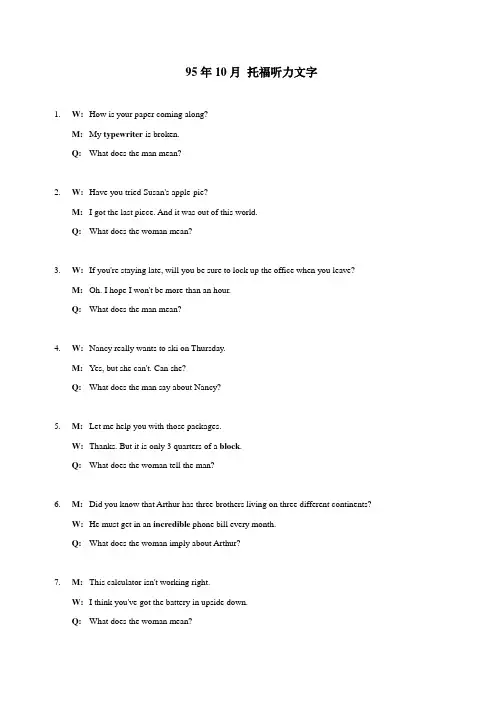
95年10月托福听力文字1.W: How is your paper coming along?M: My typewriter is broken.Q: What does the man mean?2.W: Have you tried Susan's apple-pie?M: I got the last piece. And it was out of this world.Q: What does the woman mean?3.W: If you're staying late, will you be sure to lock up the office when you leave?M: Oh. I hope I won't be more than an hour.Q: What does the man mean?4.W: Nancy really wants to ski on Thursday.M: Yes, but she can't. Can she?Q: What does the man say about Nancy?5.M: Let me help you with those packages.W: Thanks. But it is only 3 quarters of a block.Q: What does the woman tell the man?6.M: Did you know that Arthur has three brothers living on three different continents?W: He must get in an incredible phone bill every month.Q: What does the woman imply about Arthur?7.M: This calculator isn't working right.W: I think you've got the battery in upside down.Q: What does the woman mean?8.W: We should buy a good guide book and study it before our trip to Montreal.M: We could. But they're so overpriced. What about the library?Q: What does the man imply?9.W: I always want a little something to eat about this time of day.M: So do I. Let's have a snack now and then have a light lunch later.Q: What are the speakers discussing?10.M: I've just been over to my friend Tom's new apartment.It's much bigger than my place.W: But more expensive I bet.Q: What does the woman mean?11.W: Could you mail these letters for me please?M: More letters? Your friends are going to be very happy to hear from you.Q: What does the man imply about the woman?12.W: Does Prof. Ford always come to class?M: Is ice cold?Q: What does the man imply about Prof Ford?13.W: Would you have some time this week to go over these questions with me?M: How does tomorrow sound?Q: What does the man mean?14.M: Hey? John! John!W: Save your breath. He's out of earshot.Q: What does the woman mean?15.W: You only have water to serve your guests?M: This isn't just water. This is imported mineral water.Q: What does the woman imply?16.W: I see a new bookstore has just opened on Main street.M: It may be a new store. But the books are far from new.Q: What does the man mean?17.W: Alice has been spending a lot of time at the library lately.M: Well. She's got a paper do and two final exams next week.Q: What has Alice probably been doing?18.W: It's going to cost a fortune to get my car fixed.M: Why don't you just trade it in for a new one?Q: What does the man suggest the woman do?19.M: Winter is over at last. Time to pack up my gloves and boots.W: I've been waiting for this for months.Q: What does the woman mean?20.W: How did the game go the other night? Did your team win?M: Are you kidding? That would be a first.Q: What does the man imply?21.W: Danas told us he likes to play cards.M: But we've invited him three times and he hasn't come once.Q: What can be inferred about Danas?22.W: I invited my class home for coffee.M: In this tiny place?Q: What does the man imply?23.M: Excuse me; I don't understand why fight 213 has been delayed. The weather seems fine now.W: I'm afraid New York got three times as much snow as we did here. It should be clear by morning though.Q: What does the woman imply?24.M: Take a look at this gift catalog. Maybe we can find something to get Janet for her new house.W: OK. But remember we can't afford a lot.Q: What does the woman mean?25.M: Are you still waiting for Bob?W: I don't know why I bother. The store will be closed by the time we get there.Q: What does the woman mean?26.M: Would you like to come with us for coffee a little later?W: I'm off caffeine, medical restriction.Q: What does the woman mean?27.W: Mary seems surprised that she got a research grant.M: Well, she shouldn’t have been. Everybody knows that she's brilliant.Q: What does the man mean?28.M: Mind if I leave my umbrella here in the hallway?W: Not at all. But first shake it off outside, would you?Q: What does the woman tell the man?29.W: According to this article, the former boxing champion is going to try again. He's coming out of theretirement for the third time.M: Is a comeback at his age at all likely?Q: What does the man imply about the former box champion?30.W: Don't you think Prof. Morrison's test was too difficult?M: Well, I must admit I had been expecting more than just passing grade in biology.Q: What does the man mean?生词表1.typewriter ['taip,raitə] n. 打字机2.block [blɔk] n. 一批;大宗,大量3.incredible [in'kredəbl] adj. 难以置信的,惊人的4.snack [snæk] n. 小吃,快餐5.earshot ['iəʃɔt] n. 听力所及之范围6.catalog ['kætəlɔɡ] n. 目录7.caffeine ['kæfi:n] n. 咖啡因8.restriction [ri'strikʃən] n. 限制9.retirement [ri'taiəmənt] n. 退役PART B31-34have you made any plans to go away during semester break? I've been thinking of skiing.I really haven't had time to think about my vacation. I've been concentrating on getting ready for my exams, especially Philosophy. But I'll probably go to the beach.Why the beach?Well. It would be nice to get away from this cold weather and just lie in the sun and relax after working so hard. It's true that skiing does require work. And you have to get up early and wait in long lines for the chair leaves. Thanks. I think you help me make up my mind.Sure. Now maybe you can use your mind to think about something else, like your studies.你在学期休息期间做出任何计划了吗?我一直在想着滑雪。

托福听力词汇完整版文稿归稿存档编号:[KKUY-KKIO69-OTM243-OLUI129-G00I-FDQS58-新托福IBT听力场景入学:enrollment/register 登记, 注册opening ceremony n.开业典礼, 仪式commencement ceremony 毕业典礼convocation n.正式会议(可指简单的毕业典礼)orientation meeting开学说明会staff n.全体职员freshman (大学)一年级学生sophomore (大学)二年级学生junior (大学)三年级学生senior (大学)四年级学生tuition fee 费用placement test 开学测试excellent 出色的average 平均的,一般的below average 低于平均水平的,差的结构及称谓: university- president 大学,校长chancellor 名誉校长college 学院science/ arts school 理科/文科学院undergraduate 本科postgraduate /graduate 研究生建筑物buildings:canteen.餐厅/cafeteria.自助餐厅dining hall 食堂administration building 行政大楼wing/annex 配楼teaching building教学楼dormitory n.宿舍auditorium n.会堂, 礼堂=lecture hallassembly n.集合,集会computer lab 计算实验室,机房选课学科major 主修 minor 副修science理科, arts文科, engineering 工科Mathematics 数学physics 物理chemistry 化学biology 生物学(micro-微marin-海洋)geography 地理学electronics 电子学computer science 计算机科学astronomy 天文学electronics engineering 电子工程学botany 植物学psychology 心理学zoology 动物学architecture 建筑学oceanography 海洋学ecology 生态学medical science 医学archaeology 考古学history 历史学linguistic 语言学pedagogy 教育学,教学法anthropology 人类学economics 经济学statistics 统计学accounting 会计学philosophy 哲学课程类型required、 compulsory course 必修课selective/optional course选修课elective course 选修课lecture 讲座seminar 高级研讨性课colloquium n.报告课tutorial 个人辅导课程workshop 专题课程级别Introductory 入门级elementary, fundamental 初级Intermediate, secondary 中级Advanced 高级Prerequisite 先修课程上课:Syllabus 教学大纲Required textbook 要求的课本Attendance 出勤Grading system 打分体系Class participation 课堂参与Otherssemester/term 学期 quarter小学期course guideline 课程纲要exemption 免修Professor’s signature 教授的签字(用于注册课程)Course cap课程容量(可以招收的学生数)openings (可供注册的名额)Take选(课), drop 退(课)Late registration晚注册Deregistration 注销教师称号professor 教授lecturer = instructor 讲师teaching assistant = TA 助教research assistant = RA 助研counselor, adviser 咨询者,顾问president 大学校长faculty 全体教职员dean 院长coordinator 班主任,协调人tutor 个人辅导supervisor 管理人作业:assignment 作业(lab/book/oral/mix media)report 实验报告project 项目survey 调查presentation 发言term paper 学期论文(research paper)thesis/essay/dissertation 论文journal 学术期刊social investigation 社会调查questionnaire n.调查表, 问卷observation n.观察interview vt.n.采访collect data 收集数据broad (论文等)内容宽泛narrow down (论文等)缩小范围source (写论文的)参考资料critical thinking 评判性思维lack your own ideas缺少自己的想法deadline n.最终期限extension 延期due date/time期限outline n.大纲, 提纲 (roadmap) bibliography n书目, 参考书目reference 参考plagiarism n. 抄袭revise v. 修改rewrite v. 重写final draft 完成稿speech n.演讲presentation 演讲,陈述eye contact 目光接触intonation 音调考试:mid-term exam 期中考final exams = finals 期末考cumulative final 总结性考试take-home exam(拿回家的开卷考试,一般有限定的时间)open-book exam 开卷考试subjective test 主观性测试objective test 客观性测试pop quiz 抽查式测验blue book 答题本assessment n估价appraisal n.评价, 估价make up for补考,resit, retake重考grade (mark 、score)分数成绩:perfect grade 优异成绩low grade 低分high mark 高分passing grade 及格分failing grade 不及格分full marks 满分straight A's 全Abe all A's and B's 全是A和B B plus B加A minus A减pass the exam with flying colors 以优异成绩通过考试graduate with honors 以荣誉毕业diploma, degree, certificate 文凭,学位,证书考试问题:分析成绩低的原因,给出解决办法图书馆:library图书馆librarian图书管理员publication 出版物periodical 期刊magazine 杂志book catalog 图书目录classified catalog 分类目录title index 书目索引alphabetic index 按字母顺序排列的索引circulation desk借书处reserved books 馆藏书(只能在图书馆内借阅)library card 借书证overdue fine 过期罚金periodical reading room 期刊阅览室online journal 在线期刊video tape 录像带back issue 过期杂志current issue 近期杂志archive 档案non-fiction 非小说类文学作品science-fiction 科幻小说copier 复印机check out 办理(借、还)手续renew 续借overdue过期interlibrary service 馆际服务部分名称information desk n.服务台delivery/circulation desk借书台shelf n.书架(vt.)stacks 书架photocopy room复印室return area 还书处students locker 学生存储间reference section 参考书部科研过程Hypothesis 假说Alternative hypothesis择一假说Null hypothesis无效假说, 零假说Collect dataSurvey 调查Questionnaire 调查问卷Experiment 实验Interfere, influence 打扰Observation 观察Analyze data 分析数据Interpret data 翻译数据Analysis 分析Analytical 分析的Subject 主题,科目,受制于…的SampleTreatment group 实验组Control group 实验对照组校内工作,课外活动及寻找经济援助:Letter ofreference/recommendation 推荐信Competitive 竞争的Benefit future careerField research 实地调查研究Collect data for papers Waiter, waitress,Babysitter 临时保姆Work at the library Qualification资格, qualified 合格的Resume, CV 简历financial aid经济援助Scholarship/Fellowship 奖学金Teaching assistantship 助教奖学金Research assistantship 研究奖学金Grant 助学金Loan 贷款Need-based以需求为基础Merit-based 以优秀为基础Student union 学生会Clubs 俱乐部Career service住宿:宿舍:accommodation n.住处, 膳宿residence hall宿舍suite 套间studio 工作室,独立套间village 村落(校内一栋一栋的房子,可以用做宿舍)lounge n.公共大厅(可以用做娱乐)home-stay 在国外住在房东家里的那种roommate同屋者,室友corridor n. 走廊,过道,租房lease n.租借, 租约landlord 房东landlady女房东rent租金tenant 房客patio n.阳台, sliding door n.推拉门single room 单人房twin room 双人房two-bedroom apartmenthouse key 房锁匙床上用品:pillow n.枕头bed linen n. 床上用品sheet n. 被单mattress n.床垫blanket n.毯子towel n.手巾, 毛巾quilt n.棉被电器类electricappliance(instrument;equipment) 电器heater, furnace 加热器,炉子heating unit 暖气片air conditioner 空调设备stove 炉子microwave oven 微波炉washer / dryer 洗衣机/烘干机(laundry 洗衣店)utensil 器皿;用具kitchen utensil 炊具oven 烤箱;烤炉dishwasher 洗碟机washing machine 洗衣机(hot-water) heater 热水器coffeepot 咖啡壶fridge(refrigerator/freezer)冰箱vacuum cleaner 吸尘器tape player 录音机CD player CD机Laundromat 自动洗衣店maintenance 维修,保养家具类furniture 家具bookshelf 书架bookcase 书柜couch 沙发chest 柜子;橱;箱子dresser (bureau) 梳妆台cabinet (电视机等)机箱;储藏柜;陈列柜cupboard (closet) 碗橱storage wall 壁橱rug 小地毯carpet 地毯curtain 窗帘bathtub 浴缸fixture (房屋)固定装置furnishings 室内陈设日常生活/问题:personalpossessions/property/belonging s个人财产get insurance for personal possessions/property/belongs garbage/rubbish/waste n.垃圾dispose v. 处理gas meter煤气表insect n.昆虫burglar n.夜贼leaking/leakage n. 泄漏lost key丢钥匙break in 闯入讲座场景词汇Geology地质学Slide n. 滑坡Landslide n.山体滑坡Mud泥土, soil土壤Earth n. 土Sink v.下沉Ground water 地下水Irrigation n. 灌溉Freeze, froze, frozen v.冷冻Melt v.融化 moltenGravity n.重心Aggravate v.加重Lean v.倾斜Slope n.斜坡Steep adj.陡峭Erode v., erosion n.腐蚀Fossil n.化石Dinosaur n.恐龙Sediment, deposit 沉淀物Marble 大理石granite 花岗岩Ore 矿石Stalactite 钟乳石Refine v. 提炼Platinum v. 铂金Seismology 地震学Vibration, tremor, 震动Wave 波动Volcano, volcanic 火山,火山的Volcanic eruption 火山喷发Magnitude 级数Collision n.碰撞Active adj.积极的Dormant adj.休眠的Extinct adj. 熄灭的Magma n.岩浆Lava n.岩浆Erupt v.喷发explode v.爆炸 (explosion) boom n.爆炸Blast n.爆炸Avalanche n.雪崩地球科学Earth’s interior 地球的内部Seismic waves地震波Compression 压缩Shear (a deformation of an object in which parallel planes remain parallel but are shifted in a directionparallel to themselves)Slow down减慢速度Reflect 反射Depth深度Density 密度Boundary边界Mantle地幔Crust地壳Core地心Continental plate 大陆板块Tectonic plate (地球表面的)构造板块Continental drift 大陆漂移Layer, strata 层Stratify 分层Crack 裂缝Molten lava 融化的岩浆Climatic shift=Climatic changes气候变化Consistent pattern 统一的,始终一致的Solar energy太阳能Radiate 发射,放射Crude approximation 大概的猜测Speculation猜测Cooling down冷却Mechanism 机制Length of the dayPhysical force 体力Imaginary line虚拟线Artificial reservoir 人工水库LatitudeRedistribute再分配,再分布Spin 快速旋转Minerals 矿物质Diverse 多样的Specimen,Sample样品Abundant 丰富的Glassy像玻璃的Amazon stones天河石Firing vapor 炙热的水蒸汽Wipe out 根除,彻底消灭Mt Everest 珠穆朗玛峰Elevation 海拔,海拔增高Precise measurement精确的测量Global Positioning System全球定位系统Longitude 经度Latitude 维度Alternative sources of energy 可替代资源Gas hydrate气体水合物Trap 困住Flame 火焰Potential 潜在的Model 模式Geological fault地质断层Crack 裂缝seismic gap地震活动空白地带postulate 假设chunk 大块cylinder 圆柱cylindrical 圆柱形的ground tilt measurement地倾斜观测evacuate 撤出sedimentary adj. 沉淀性的accumulate 积累商业Insurance 保险Note 注意Contract合约Verbal agreement口头协议Repay 偿还Interest 利息Merchant 商人Cautious 谨慎的Paramount 极为重要的Manufacture 制造Label 标签Contention 所持观点Inform 告知Cost成本Profit利润loss损失Net净的,gross粗略的Supply and demand供求Supply chain供应链Fluctuation 浮动Recession 衰退Depression 萧条Marketing strategies市场营销策略Survey 调查Surplus 剩余Shipment 运输Distribution 分布Retail 零售Whole sale 批发Franchise特许经营Budget预算哲学Socrates, Plato and Aristotle Theme 主题Logic 逻辑Rhetoric 修辞Fundamental causes 基本原因Principles of the universe 宇宙的原则Perceive 看待,观察Perception 观点Sense 感觉Soul 灵魂spiritElement 组成成分Reasoning 推理Ration理性, rational有理性的Contemplation 沉思,思考Judgment判断Just公正的,justice公正Justify证明, justification 合理的理由Explicit 明确的Ethics道德规范Ethical theory 伦理理论Moral 有道德的Ultimate truth终极真理Universal 普遍的Search for truth 追求真理Vary v.不相同Intrinsic 内部的Extrinsic 外部的Critic 评论家Old-fashioned 过时的Valuable 有价值的Survive 生存,存活Conservative 保守的Liberal 开放的Impractical不实际的Empirical经验主义的Cognitive 认知的Weaken 削弱Diminish (影响力)减小Medieval 中世纪Renaissance 文艺复兴Doctrine教义,主义,学说Idealism 唯心论,理想主义Epistemology n. 认识论Metaphysics形而上学,玄学Reconcile和解,调停天文学astronomy constellation 星座zodiac (星象学的星座)planet 行星sun 恒星Jupiter 木星Pluto 冥王星Saturn 土星Mercury 水星Mars 火星Venus金星Neptune海王星Uranus天王星Ceres 谷物星(the largest asteroid and the first discovered)White dwarf 白矮星Big Dipper 北斗七星Asteroid belt 小行星带Milky Way 银河系Galaxy n.星系orbit v.运行n.轨道rotate v. 转Axis n.轴track n. 轨道outer space外太空gravity n.重力equator n.赤道tropical 热带的brightness n.亮度dimension n.维度distance n. 距离Eclipse (日月食)Wane, diminish v. 逐渐变小Centripetal 向心Centrifugal 离心Nebula 星云(an immense cloud of gas (mainly hydrogen) and dust in interstellar space)Nebulous adj. 星云的Gas 气体 (rock, ice, hydrogen, oxygen)Particle 微粒Polar light 极光Astronomical 天文的Astrophysics 天文物理学Big Dipper 北斗七星Black hole 黑洞Celestial天体的Celestial map 天体图Centrifugal force 离心力Chondrite 球粒状陨石Chromosphere太阳的色球层Clockwise 顺时针Cluster 星团,一群星星Comet 彗星Cosmos宇宙,cosmetic宇宙的Cosmology宇宙学Emission 排放物,发射Faint 微弱的Feeble 微弱的Gaseous bodies 气态包Gravitational force 吸引力Greenwich mean time 格林尼治时间High resolution 高清晰度Ignite 引燃Illusive object 幻影物体Image 影响,形象Infinite 无限的Infrared ray 红外射线Interferometer 干扰仪Intergalactic 星系间的International date line 国际日期变更线Interplanetary 星球间的Interstellar星际的Leap year 闰年Light year光年Luminosity光亮度Lunar阴历的,月亮的Massive 巨大的Meteor流星Meteor shower 流星雨Meteorite陨石Meteoroid流星体Molten 融化的Naked eye 裸眼Observatory 天文台Photosphere 光球层Planetarium 天文馆Planetoid 小行星Polestar 北极星Pseudoscience 伪科学Quasar类星体Radiation 辐射Revolution 旋转Rotation 旋转Satellite 卫星Sky atlas天体图Solar corona日冕Space debris 太空垃圾Space shuttle 太空飞船Space suit 太空服Spin 快速旋转Star cluster 星群,星团Stellar 星星的Sunspot 太阳黑子Time difference 时差Time zone 时区表演艺术(舞蹈,电影,音乐etc.)Genre 艺术分类Performing art 表演艺术modern dance piece现代舞concert 音乐会play剧opera歌剧film 电影camera 摄影camera shotanalytical 分析的parallel 平行的ballet芭蕾舞choreographer 舞蹈指导Fine/visual arts 视觉艺术Abstract art抽象艺术landscape风景photography摄影exposure 曝光develop film 冲洗胶卷negative n. 底片portrait(portray v. )肖像, 人像、still life静物sculpture雕塑statue 人物雕像lifelike 逼真的vivid anthem 国歌Critic 评论家Criticism 批评,评论Review n.评论Masterpiece 杰作Have aesthetic value 有美学价值Aesthetic appeal 美学吸引力Feature 特点Characteristics 特点Distinct adj.与众不同的Unique 独一无二的Style 风格Technique 技巧Gallery n.画馆Edition n.专辑Release v. 发行Debut n.首映Impressionist 印象主义者Impressionism 印象派Perspective 透视法Angle 角度Press/Publishing house出版社Acclaim v. 盛赞mirage 海市蜃楼prolific 多产Preserve v. 保存Extinct adj.灭绝的,消失的文学Literature 文学Poetry诗歌biography传记autobiography 自传detective stories 侦探小说drama戏剧novel小说Novelist 小说家collection of short stories短篇小说集Allegory寓言Comparative literature比较文学Diary 日记Editorial 社论,重要评论Fiction 小说Aestheticism 唯美Autobiography 自传Descriptive prose 描述散文Fairy tale 童话Futurism 未来派Legend 传说Literary studies 文学研究Narrative prose 叙述性散文Podium 讲台Prose 散文Realism 现实主义School of literature 文学派别Leading character 主要角色Literary criticism 文学评论Literary studies 文学学习Modernism 现代主义Plot 情节Poetry 诗歌Prologue前言Proverb谚语Surrealism 超现实主义美术Art gallery艺廊Calligraphy书法Imitating模仿Landscape painting风景画Oil painting油画Paste粘贴Crayon 蜡笔,粉笔,颜料Pigmentation 颜料Canvas 帆布Wax 蜡Spectrum 光谱Perspective透视画法Poster海报Portrait肖像Model模式,模特mural 壁画Panorama全景Pastel drawing蜡笔画Sketch草图Autograph手稿建筑Architecture建筑学Architect建筑师Architectural style建筑风格Art deco 装饰艺术Art moderneGeometric patterns 几何图形Arch 拱门Castle 城堡Cathedral大教堂Framing结构Lobby n. 大厅(entrance hall) Elevator n. 电梯Fa?ade n. 正面Stairs 楼梯Interior 内部的Exterior 外部的Impressionistic style印象派风格Mosque清真寺Pyramid金字塔Revival 复活Renaissance 文艺复兴Medieval中世纪527 (Sofia)-1520音乐Accompaniment 伴奏Audition 试听,试表演Band music 乐队音乐Chord弦乐,弦Classical music古典音乐Concerto 协奏曲Lullaby 催眠曲Duet 二重奏Harmony 和弦,和谐Rock and roll 摇滚Serenade 小夜曲Solo 独奏Sonata 奏鸣曲Symphony 交响乐Ballad歌谣Folk music 民间音乐Prelude 前奏Epilogue 尾声Score 乐谱Note 音符Notation 乐谱,记号法Chord symbol和弦符号Lyrics 歌词Tempo 节奏Melody 主旋律Rhythm节奏Tune 旋律Conduct 指挥Violin 小提琴Viola 中提琴Cello大提琴Oboe双簧管Clarinet单簧管krummhorn['kr?mh?:n]n. 变号(一种古双簧乐器)Harp 竖琴考古anthropologist 人类学家ecological 生态的anthropologist 生态人类学家archaeology 考古学anthropology 人类学morphology 形态学Ancient civilization 古代文明origin 起源originate 起源于ancestor 祖先hominid 人(科)homogeneous 同一种族(种类)的tribe 部落clan 氏族archeologist 考古学家excavation 挖掘excavate (unearth) 挖掘Scoop铲子ruins 遗迹,废墟remains 遗迹,遗骸artifact 手工艺品pottery 陶器 (potter) Porcelain瓷器fossil 化石relic 遗物,文物Rock painting 岩石画antique 古物,古董antiquity 古代,古老skull 颅骨Cranial颅骨的Stone Age 石器时代Bronze Age (青)铜器时代Iron Age 铁器时代Paleolithic 旧石器时代的Mesolithic 中石器时代的Neolithic 新石器时代的Exhume 挖掘Paleoanthropology Prehistoric史前的Primitive原始的动物微生物Amino acid 氨基酸Antibody 抗体Bacterium 细菌Biological agency Calcium钙Carbohydrate 碳水化合物Carbon dioxide 二氧化碳Cell细胞Chromosome 染色体Disinfection 消毒Enzymes 酶Fatigue 疲惫Fermentation 发酵Fungus 菌类Gene基因Genetic engineering 基因工程学Glucose 葡萄糖Immunology免疫学Incubation 孵蛋Inflection传染Malaria 疟疾Microbe 微生物Nucleus 细胞核One-celled单细胞的Oxidation氧化Parasitic animal 寄生动物Parasite disease 寄生虫病Parasitology 寄生虫学Pathogen 病菌,病原体Protozoa 原生动物Sanitation 卫生Schistosomiaisis 血吸虫病Starch 淀粉Sterilization 消毒Toxin 毒素Vaccine 疫苗Virus 病毒Yeast 酵母动物living organism 生物bacterium(pl.bacteria) 细菌algae海藻coral珊瑚rodent 啮齿类动物primate 灵长类动物ape 猿chimpanzee n. 黑猩猩gorilla 大猩猩monkey n. 猴子mammal 哺乳类动物dinosaur n.恐龙bat (ecolotion) 蝙蝠(声波定位)snowshoe hare 雪兔子raccoon 浣熊polar bear 北极熊snout (动物的)口鼻部;reptile 爬行类动物snake, cobra眼镜蛇, rattle snake 响尾蛇lizard蜥蜴,snail 蜗牛amphibian adj. 两栖动物crocodile 鳄鱼frog n. 青蛙tadpole 蝌蚪toad 蟾蜍pond 池塘puddle 水坑insect n.昆虫mosquito 蚊子fly 苍蝇cricket 蟋蟀grasshopper 蚱蜢honey beemonarch butterfly 大花蝶large migratory American butterfly having deep orange wings with black and white markings; the larvae feed on milkweedegg 卵larvae 幼虫caterpillar 毛虫pupa/ chrysalis 茧termite n. 白蚁marine adj. 海洋的beaver 狸whale 鲸shark 鲨鱼dolphin 海豚penguin 企鹅predator n. 捕食者prey n. 被捕食者aquatic adj.水生的shrimp 虾lobster 龙虾clam 蚌crab 螃蟹bird, humming birdartery 动脉scale 鳞片claw爪 , paw爪子horn 角hormone 荷尔蒙intestine 肠hive 蜂巢pollen n. 花粉pollinate v.授粉hibernate 冬眠migrate v. 迁徙communicate v. 交流保护色evolve 进化evolution n. 进化endotherm n.温血动物,恒温动物poikilotherm n. 冷血动物beak 鸟嘴enzymes 酵母secretion(n.) secrete(v.) 分泌pancreas 胰腺odor 气味(还有aroma fragrance scent smell)gland 腺体chromosome 染色体植物botany植物学botanist 植物学家tundra苔原;冻土地带,冻原fungus(pl. fungi ) 菌类laurel 月桂chestnut tree 栗子树root 根branch 枝stem 茎algae(pl. alga) 海藻organism 有机物birch tree (bark) 桦树crops 谷物corn 玉米maize 玉米chlorophyll 叶绿素amino acids 氨基酸protein 蛋白质nitrogen 氮photosynthetic(adj.) photosynthesis(n.) 光合作用lichen 地衣,苔藓squash 南瓜one of a group of large vegetables with solid flesh and hard skins, such as PUMPKIN sbean 豆类植物nectar花蜜flower花floral 花的petal 花瓣bloom 开花blossom 花pollen花粉moss 苔藓herbicide 除草剂herb 草本植物herbivorous 食草的classification 分类hierarchy 级别hazardous 有毒害的Meteorology 气象meteorology 气象meteorologist 气象学家forecast (predict) 预报climate 气候atmosphere 大气层troposphere 对流层Convection 对流Stratosphere 同温层Barometer 气压计current (气)流vapor 蒸汽evaporate 蒸发damp (wet; moist; humid) 潮湿的humidity 湿度moisture 潮湿;水分saturate 饱和absorb 吸收dew 露frost 霜fog (mist) 雾smog 烟雾droplet 小水珠condense 浓缩crystal 水晶体downpour (torrential rain) 大雨tempest (storm) 暴风雨drizzle 细雨shower 阵雨hail 冰雹blizzard (snowstorm) 暴风雪avalanche (snowslide) 雪崩precipitation (雨、露、雪等)降水Thunder 雷Lightening 闪电breeze 微风Blast 大风gale 大风whirlwind 旋风Cyclone 旋风,飓风typhoon 台风hurricane 飓风Monsoon 季风Sandstorm沙尘暴Dust storm沙尘暴tornado (twister, cyclone) 龙卷风Tropical depression热带低气压Wind direction 风向Wind velocity 风速Wind scale 风力funnel 漏斗,漏斗云cumulonimbus 积雨云disaster (calamity, catastrophe) 灾难devastation 破坏submerge 淹没overwhelm v. 淹没drought 干旱Avalanche雪崩Balmy 温和的Chilly寒冷的Frigid僵硬的,严格的Heat-wave热浪Tepid adj.微温的环保environmental protection 环境保护environmentally-friendly 环保的preserve v.保护,保存污染:pollute, pollution, pollutant contaminant n.污染物contaminate v.污染ecosystem生态系统ecology n.生态学antiseptic adj.防腐的atmospheric pollution大气污染垃圾: rubbish, garbage, trash, waste, litter处理: dispose of, burn, bury (landfill),recycle, reduce, reuse,dump 回收:glass, paper, water, milk carton牛奶盒, tyre, aluminium cans铝罐,plastic bags, rubbish bags biodegradable packaging可降解包装,throwaway 可丢弃的disposable 可丢弃的discourage v. 不鼓励燃料none-renewable 不可再生的fossil fuels矿石燃料:natural gas, coal, petroleum limited/finite natural resources 有限的自然资源alternative energy替代能源, replace=substitute v.取代wind power, hydropower水电, solar (lunar) power太阳能, nuclear power核能radioactivity n. 辐射性use up, deplete, exhaust v. 用光,耗尽conserve v. 节省,节约,污染: water pollution, air pollution,soil pollution土壤污染,noise pollutionsoil erosion 土壤侵蚀soil pollution土壤污染stain n.污染,污点,玷污stink v.发出臭味tar n.焦油toxic chemical 有毒的化学物品fume n.烟,气味light pollution日光污染refuse废物sewage污水pesticide n.杀虫剂chemical waste化学废料congest v.使充满危害动物:poaching非法打猎,盗猎, damage natural habitat破坏自然栖息地,rare breed稀有物种, endangered species濒危物种, extinct adj.灭绝 (die out, disappear),animal rights activist动物权益保护者 ,natural reserve(giant panda大熊猫)自然保护区,protect wild life保护野生动物, preserve v.保护disastrous灾难性的,devastation破坏,have disastrous effect on…对。
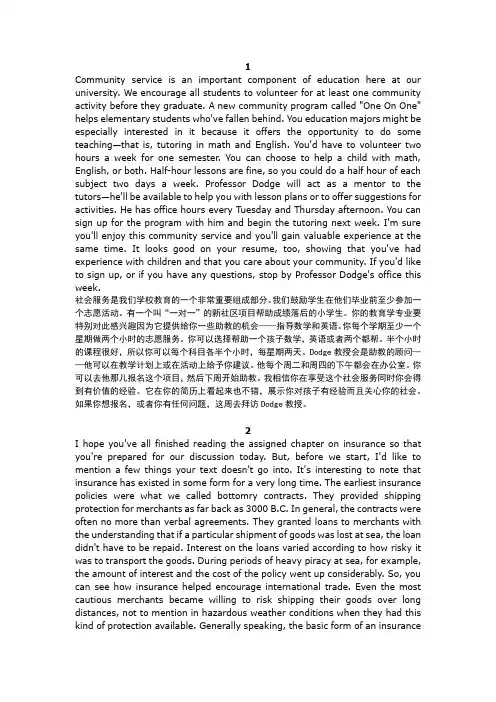
1Community service is an important component of education here at our university. We encourage all students to volunteer for at least one community activity before they graduate. A new community program called "One On One" helps elementary students who've fallen behind. You education majors might be especially interested in it because it offers the opportunity to do some teaching—that is, tutoring in math and English. You'd have to volunteer two hours a week for one semester. You can choose to help a child with math, English, or both. Half-hour lessons are fine, so you could do a half hour of each subject two days a week. Professor Dodge will act as a mentor to the tutors—he'll be available to help you with lesson plans or to offer suggestions for activities. He has office hours every Tuesday and Thursday afternoon. You can sign up for the program with him and begin the tutoring next week. I'm sure you'll enjoy this community service and you'll gain valuable experience at the same time. It looks good on your resume, too, showing that you've had experience with children and that you care about your community. If you'd like to sign up, or if you have any questions, stop by Professor Dodge's office this week.社会服务是我们学校教育的一个非常重要组成部分。
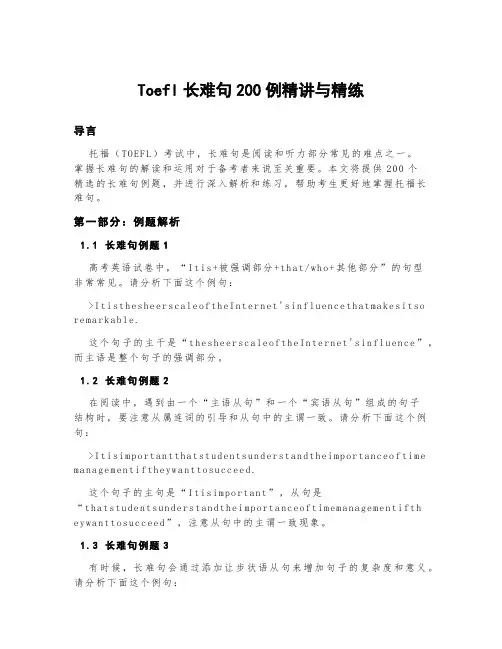
Toefl长难句200例精讲与精练导言托福(T OE FL)考试中,长难句是阅读和听力部分常见的难点之一。
掌握长难句的解读和运用对于备考者来说至关重要。
本文将提供200个精选的长难句例题,并进行深入解析和练习,帮助考生更好地掌握托福长难句。
第一部分:例题解析1.1长难句例题1高考英语试卷中,“I t is+被强调部分+th a t/wh o+其他部分”的句型非常常见。
请分析下面这个例句:>I ti st he sh ee rs cal e of th eI nt er ne t's i nf lu en ce th at mak e si ts or e ma rk ab le.这个句子的主干是“t he sh ee rs ca le of t he In te rn et's inf l ue nc e”,而主语是整个句子的强调部分。
1.2长难句例题2在阅读中,遇到由一个“主语从句”和一个“宾语从句”组成的句子结构时,要注意从属连词的引导和从句中的主谓一致。
请分析下面这个例句:>I ti si mp or ta nt tha t st ud en ts un de rst a nd th ei mp or ta nce o ft im em a na ge me nt if th eyw a nt to su cc ee d.这个句子的主句是“I t is im po rt an t”,从句是“t ha ts tu de nt su nd e rs ta nd th ei mp ort a nc eo ft im em an age m en ti ft he y wa nt to su cc ee d”,注意从句中的主谓一致现象。
1.3长难句例题3有时候,长难句会通过添加让步状语从句来增加句子的复杂度和意义。
请分析下面这个例句:>D es pi te be in gt ire d,I de ci de dt og ofo r ar un.这个句子中,“D esp i t e be in gt ir ed”是一个让步状语从句,它表达了尽管疲倦,但我还是决定去跑步的意思。
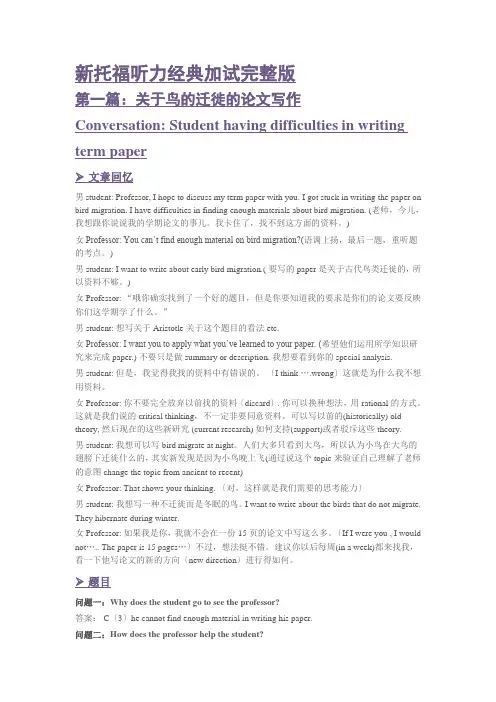
新托福听力经典加试完整版第一篇:关于鸟的迁徙的论文写作Conversation: Student having difficulties in writing term paper➢文章回忆男student: Professor, I hope to discuss my term paper with you. I got stuck in writing the paper on bird migration. I have difficulties in finding enough materials about bird migration. (老师,今儿,我想跟你说说我的学期论文的事儿。
我卡住了,找不到这方面的资料。
)女Professor: You can’t find enough material on bird migration?(语调上扬,最后一题,重听题的考点。
)男student: I want to write about early bird migration.( 要写的paper是关于古代鸟类迁徙的,所以资料不够。
)女Professor: “哦你确实找到了一个好的题目,但是你要知道我的要求是你们的论文要反映你们这学期学了什么。
”男 student: 想写关于Aristotle关于这个题目的看法 etc.女Professor: I want you to apply what you’ve learned to your paper. (希望他们运用所学知识研究来完成paper.) 不要只是做 summary or description. 我想要看到你的special analysis.男 student: 但是,我觉得我找的资料中有错误的。
〔I think ….wrong〕这就是为什么我不想用资料。
女 Professor: 你不要完全放弃以前找的资料〔discard〕. 你可以换种想法,用rational 的方式。

智 课 网 托 福 备 考 资 料托福听力TPO11原文 Lecture 3-智课教育旗下智课教育以下是小编为大家整理的托福听力TPO11原文中Lecture 3的文本内容,希望大家能够认真阅读,不懂的地方可以参考翻译,相信会有所收获。
下面就让小编来为大家介绍一下托福听力TPO11原文中Lecture 3的文本内容吧,大家要好好把握,这些都是非常有价值的材料,同时,大家也可以登录智课教育论坛进行TPO练习辅导,希望能够给准备托福听力的同学带来帮助。
TPO11 Lecture 3 Environmental scienceProfessor:When land gets develop for human use, the landscape changes. We don’t see as many types of vegetation, trees, grasses and so forth. This in turn leads to other losses: the loss of animal that once lived there. Err…but these are the obvious changes, but there are also less obvious changes like the climate.One interesting case of this…of…of changes in the local land use causing changes in climate, specifically the temperature is in Florida. Now what comes to mind when you think of the state of Florida?Student A:Sunshine, beaches.Student B:Warm weather, oranges…Professor:Yes, exactly. Florida has long had a great citric industry; large growth of oranges, lemons and the like. Florida’s winter is very mild; the temperature doesn’t often get below freezing. But there are some areas in Florida that do freeze. So in the early 1900s, farmers moved even further south in Florida, to areas that were even less likely to freeze. Obviously, freezing temperatures are danger to the crops. A bad barrier of cold weather, a long spell of frosts could ruin a farm and the entire crop, anyway, before these citric growers moved south, much of the land in south Florida, was what we called wetlands.Wetlands are areas of marshy, swampy land, areas where water covers thesoil, or is present either at or near the surface of the soil for large part of the year. Wetlands have their own unique ecosystem, with plants and animals with special an interesting adaptation. Very exciting, but it’s not what we are talking about today. Emm…where was I?Student A:Farmers moved south?Professor:Oh, yes. Farmers moved south. But the land was not suitable for farming. You can’t grow orange in wetland, so farmers had to transform the wetlands into lands suitable for farming. To do that, you have to drain the water from theland,move the water elsewhere, and divert to the water sources such as rivers. Hundreds of miles of drainage canals were built in the wetlands. Now these areas, the new areas the farmers moved to, used to be warm and unlikely to freeze, however, recently the area has become susceptible to freezes. And we are trying to understand why.Student B:Is it some global temperature change or weather pattern like El Ni?o or something?Professor:Well, there are two theories. One idea is as you suggested that major weather patterns, something like El Ni?o, are responsible. But the other idea and this is the one that I personally subscribe to, is of the changes in the temperature pattern had been brought about by the loss of wetlands.Student A:Well, how would the loss of wetlands make a difference?Professor:Well, think about what we’ve been studying so far. We discussed the impact of landscapes on temperature, right? What affects does the body of water have on an area?Student A:Oh, yeah. Bodies of water tend to absorb the heat during the day, and then they release the heat at night.Professor:Yes, exactly. What you just said is what I want you all to understand. Bodies of water release heat and moisture backinto the environment. So places near large bodies of water are generally milder, err...slightly warmer than those without water. And what I, another think is that the loss of the wetlands has created the situation where the local temperatures in the area are not slightly different, slightly colder than they were 100 years ago, before the wetland were drained.Student B:Emm…do we know what the temperature was like back then?Professor:Well, we were able to estimate this. We have data about South Florida’s current landscape, emm…the plant cover. And we were able to reconstruct data about the landscape prior to 1900. Then we enter those data, information about what the landscape look like before and after the wetlands weredrained.We enter the data into a computer weather model. This model can predict temperatures. And when all the data were entered, an overall cooling trend was predicted by the model.Student B:How much colder does it get now?Professor:Well, actually the model shows a drop of only a few degrees Celsius. But this is enough to cause dramatic damage to crops. If temperatures over night are already very close to the freezing point, then this drop of just a few degrees can take the temperature below freezing. And freezing causes frosts, which kill crops. These damaging frosts wouldn’t happen if the wetlands were still in existence, just as the tiny temperature difference can have major consequences.《环境科学》教授:当土地发展到适应人类使用,景色就发生了变化。
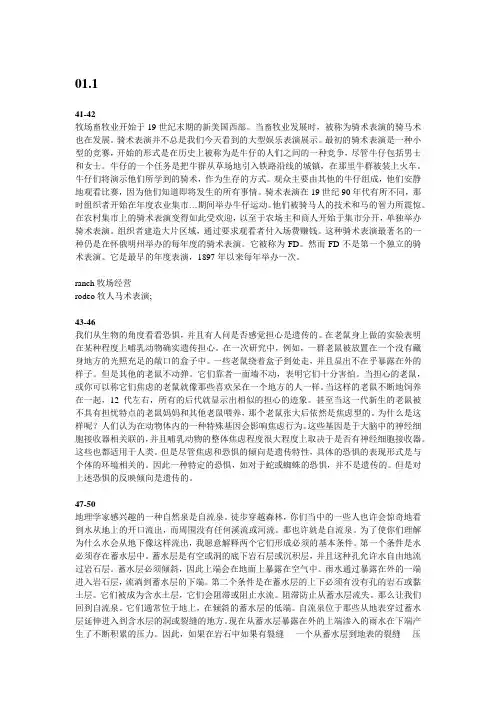
01.141-42牧场畜牧业开始于19世纪末期的新美国西部。
当畜牧业发展时,被称为骑术表演的骑马术也在发展。
骑术表演并不总是我们今天看到的大型娱乐表演展示。
最初的骑术表演是一种小型的竞赛,开始的形式是在历史上被称为是牛仔的人们之间的一种竞争,尽管牛仔包括男士和女士。
牛仔的一个任务是把牛群从草场地引入铁路沿线的城镇,在那里牛群被装上火车。
牛仔们将演示他们所学到的骑术,作为生存的方式。
观众主要由其他的牛仔组成,他们安静地观看比赛,因为他们知道即将发生的所有事情。
骑术表演在19世纪90年代有所不同,那时组织者开始在年度农业集市…期间举办牛仔运动。
他们被骑马人的技术和马的智力所震惊。
在农村集市上的骑术表演变得如此受欢迎,以至于农场主和商人开始于集市分开,单独举办骑术表演。
组织者建造大片区域,通过要求观看者付入场费赚钱。
这种骑术表演最著名的一种仍是在怀俄明州举办的每年度的骑术表演。
它被称为FD。
然而FD不是第一个独立的骑术表演。
它是最早的年度表演,1897年以来每年举办一次。
ranch牧场经营rodeo牧人马术表演;43-46我们从生物的角度看看恐惧,并且有人问是否感觉担心是遗传的。
在老鼠身上做的实验表明在某种程度上哺乳动物确实遗传担心。
在一次研究中,例如,一群老鼠被放置在一个没有藏身地方的光照充足的敞口的盒子中。
一些老鼠绕着盒子到处走,并且显出不在乎暴露在外的样子。
但是其他的老鼠不动弹。
它们靠者一面墙不动,表明它们十分害怕。
当担心的老鼠,或你可以称它们焦虑的老鼠就像那些喜欢呆在一个地方的人一样。
当这样的老鼠不断地饲养在一起,12代左右,所有的后代就显示出相似的担心的迹象。
甚至当这一代新生的老鼠被不具有担忧特点的老鼠妈妈和其他老鼠喂养,那个老鼠张大后依然是焦虑型的。
为什么是这样呢?人们认为在动物体内的一种特殊基因会影响焦虑行为。
这些基因是于大脑中的神经细胞接收器相关联的,并且哺乳动物的整体焦虑程度很大程度上取决于是否有神经细胞接收器。
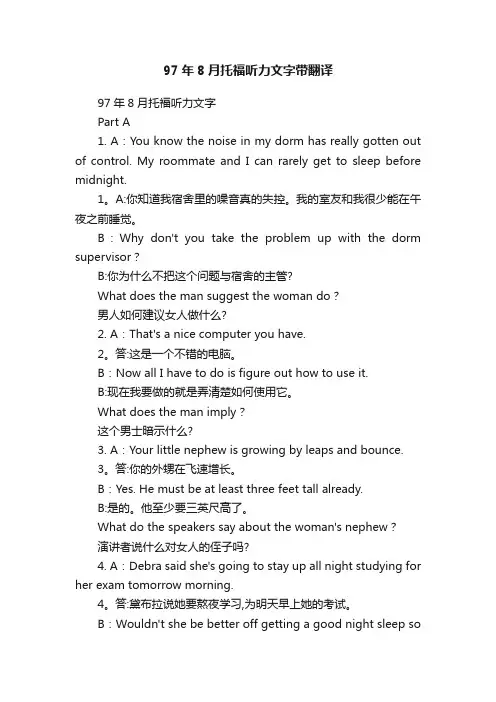
97年8月托福听力文字带翻译97年8月托福听力文字Part A1. A:You know the noise in my dorm has really gotten out of control. My roommate and I can rarely get to sleep before midnight.1。
A:你知道我宿舍里的噪音真的失控。
我的室友和我很少能在午夜之前睡觉。
B:Why don't you take the problem up with the dorm supervisor?B:你为什么不把这个问题与宿舍的主管?What does the man suggest the woman do?男人如何建议女人做什么?2. A:That's a nice computer you have.2。
答:这是一个不错的电脑。
B:Now all I have to do is figure out how to use it.B:现在我要做的就是弄清楚如何使用它。
What does the man imply?这个男士暗示什么?3. A:Your little nephew is growing by leaps and bounce.3。
答:你的外甥在飞速增长。
B:Yes. He must be at least three feet tall already.B:是的。
他至少要三英尺高了。
What do the speakers say about the woman's nephew?演讲者说什么对女人的侄子吗?4. A:Debra said she's going to stay up all night studying for her exam tomorrow morning.4。
答:黛布拉说她要熬夜学习,为明天早上她的考试。
B:Wouldn't she be better off getting a good night sleep soshe'll feel fresh in the morning?B:不,她是更好的得到一个好觉,所以她会感觉新鲜早上?What does the man imply?这个男士暗示什么?5. A:Did you pick up your letter at the post office?5。
目录第一部分阅读2一.真题高频词汇21天速成 (2)二.新托福阅读考试中句际关系解读 (21)三.逻辑 Or 语义——托福阅读句子简化题新攻略 (26)四.托福阅读之插入文本题解题思路剖析 (29)五.阅读真题三篇 (32)六.样题两篇 (50)七.最新考情 (56)第二部分听力 (58)一.新托福听力文章段落和出题点解析 (58)二.新托福听力笔记之图像记忆法 (62)三.托福听力新方法 (66)四.备考概述 (66)五.听力演练 (67)六.听力真题场景词汇 (100)第三部分口语 (170)一.Speaking Tips For TOEFL iBT (170)二.托福口语满分=mission impossible? (173)三.搞定口语TASKS (175)四.练习 (182)五.补充练习 (202)第四部分写作 (204)一.新托福作文特点浅析 (204)二.托福独立写作思路扩展 (207)三.独立写作 (209)四.综合写作 (229)五. 托福写作结构模式 (235)六.“6+1”托福独立写作心经 (252)附录 (257)附录(一)2012年托福考试独立写作汇总 (257)附录(二)2013年托福考试独立写作汇总 (261)附录(三)2013年NA托福写作真题汇总及解析 (264)第一部分阅读一.真题高频词汇21天速成Day 11. a matter of speculation supposition n.推断2. a solicitation of an invitation of n.恳求3.abandon give up v. 放弃4.abandoned left a.被遗弃的5.aberrant abnormal a.脱离常轨的6.abolish end v. 终止;取消7.abort quit v.夭折;中止8.abrupt sudden a 突然的9.abruptly suddenly ad.突然地;意外地10.absorb appeal/learn/take in v.吸收11.abstract not concrete a.抽象的;非实际的12.absurd ridiculous a.荒谬的;可笑的13.abundance laager amount/great number/14.plenty n.大量15.abundantaffluent/ample/numerous/plentiful/16.substantial a.丰富的17.abundantly plentifully ad.丰富地;大量地18.accelerate speed up/get faster v. 加速,提前19.access reach v. 接近20.accessible reachable/easy to reach a.可接近的21.accidental unexpected/unintentionala.意外的;偶然的22.accommodate provide for v. 提供23.accomplished achieved/ skilled a.实现完成的24.account description n. 说明25.account for explain v. 说明26.accrete come together v. 合成27.accumulate collect/pile up/build up v.积累;聚集29. accumulate increase v. 积累28.accumulation deposit n. 沉淀物29.accurate correct a. 正确的30.accurately correctly ad. 正确地31.acknowledge recognize v. 承认32.acquire obtain v. 获得33.actually in fact ad. 事实上34.added extra a.附加的;额外的35.adept skilled a.熟练的36.adequately sufficiently adv. 足够地37.adherent supporter/advocate n.拥护者38.adjacency nearing n.临近39.adjacent nearby a. 毗连的40.adjacent neighboring a.毗连的41.adjust modify v.调整42.administer manage v. 管理43.admit let in v. 准许进入44.adopt enact v. 采用45.advance improvement n.发展;增长46.advent arrival/beginning n.出现;到来47.affair matter n.事件;事情48.afford provide/offer v.提供;给予49.aggravate increase/annoy v.加重;增剧;使恼火50.aggravate annoy v.使恼火51.aggregate overall/combined a.聚集的aggregation group n. 聚合52.agile astute/clever/quick and active/moveand act quickly a.灵活的;敏捷的53.alarm sound/ warning v.警报54.albeit although/even though conj. 尽管;虽然55.alleged supposed v. 假设,断言56.allow enable v.允许57.allude suggest v.暗示58.allude to refer to v.提到59.allusion reference n. 暗示;提及60.ally with link to v.结盟61.alter change to v.改变62.amazing remarkable/ a.令人惊讶的、非凡的63.ambiguous vague a.不明确的64.ambivalent mixed a.矛盾的65.ample plentiful/ spacious a.充足的66.ancestor forefather/progenitorn. 祖先,前辈67.anchor hold in place v.使固定68.ancient old/antique a.古老的69.annihilate destroy/completely removev.消灭70.annihilated destroy v. 废止71.annually yearly ad.每年72.anomaly irregularity n.异常的人或物73.anonymous nameless/incognito a. 匿名的74.antagonist competitor n. 对手75.anticipate expect v. 预期76.antiseptic clean a.抗菌的77.antithesis opposite n.对立面78.antler horn n. 鹿角79.anxiety worry n. 忧虑;担心80.apart from exception/except for phr.除了…之外81.apparatus equipment n. 仪器;设备Day 21.apparent o bvious a. 显然的2.apparently clearly ad. 显然地3.appeal attraction n. 吸引力4.appealing attractive a.有吸引力的5.appear seem v. 似乎6.appearance rise/arrival/showing up n.出现7.application use n. 应用8.appreciable noticeable a.相当可观的9.approach method n. 方法10.approach move toward v. 接近11.approximately roughly ad. 大约地12.architecture structure n. 构造13.archive record/stock v. 存档14.arduous difficult a. 艰巨的15.arid dry a. 干旱的16.arise emerge/come about v. 出现17.arrangement configuration n. 安排;布置18.array range n. 一系列19.article item/object n. 物品20.artificial not real a. 虚伪的21.as a rule in general phr. 通常22.assert declare v. 断言;宣称23.assertion strong statement n. 断言24.asset advantage n. 资产;有利条件25.assimilate combine v. 同化26.assistance help n. 帮助;协助27.associated connected a. 关联的28.assorted various a. 各式各样的29.assume believe/suppose v. 假定30.assume take on v. 承担31.assumption premise n. 假设32.assure guarantee v. 担保33.astonishing amazing/incredible a.惊人的34.astoundingly incredibly adv. 使人震惊的35.astute clever a. 敏锐的36.at random without a definite patternphr. 随便地; 任意地37.attachment to preference for n. 依恋38.attain achieve v. 达到;获得39.attainment achievement n. 达到;获得40.attendant accompanying a. 伴随的41.attest to confirm v. 证实42.attribute accredit/ ascribe v.把…归于;认为43.attribute characteristic n. 特点44.attribute to credit with v. 归于45.attribution character n. 属性46.augment increase v. 增加;提高47.authenticity genuineness n. 真实48.autonomous independent a. 自主的49.available obtainable a. 可获得的50.avenue method/means n. 途径;手段51.avid enthusiastic a. 热衷的52.back up support n. 支持,援助53.barely just ad. 仅仅54.barge boat n. 驳船55.barrier obstacle/impediment n.障碍56.battle struggle n. 搏斗;奋斗57.be inclined tend v. 倾向58.be accustomed to get used to phr./v.习惯59.be aware of familiar with phr./v.了解60.be beforehand foreordain v. 预先61.be closer resemblance to be more likephr. 非常相似62.be consistent with be compatible with phr.一致的63.be entitled to have the right phr./v.有…权利64.be susceptible to be subject to 受…影响的65.beckon invite v. 招唤66.become extinct die out phr./v. 灭绝67.being creature n. 生命68.beneficial advantageous a. 有益的69.blossom flourish/thrive v. 兴旺70.boast puff/exaggerate v. 吹嘘71.bombard assail/assault/strike v.炮击;轰击72.boom expansion n. 激增73.boon great benefit n. 利益74.boost raise v. 增加75.boundary periphery n. 边界76.branch division n. 分支77.breakthrough revolution n. 突破78.breed reproduce v. 繁殖79.brew develop vt. 开发80.brilliant bright a. 光辉的81.brittle breakable/fragile a.脆弱的82.broad appeal wide popularity a.广泛的吸引力83.broadly generally/extensively ad.大体上84.bulk majority/large part/largeportion/great quantity n. 大部份85.bulk major part n. 主体Day 31.burgeon expand v. 急速成长2.bustling lively/ busy a. 活跃的;忙乱的3.by and large for the most part 总的来说4.camouflage disguise/hide/decorate/blendwith circumstances v. 伪装5.cardinal fundamentala. 基本的6.cargo shipment n. 船货7.catastrophic badly harmful a. 灾难性的8.celebrated famous a. 着名的9.central essential a. 主要的10.certain specified a. 指定的11.champion promote vt.提升,提拔12.championed supported v. 支持13.chancy risky a. 冒险的14.channel provide/direct/guidev. 提供;引导15.chaotic disorganized a. 混乱的16.cherish value v. 珍爱17.chief major a. 主要的18.chisel carve v. 刻;凿19.choose opt v. 选择20.chronic persistent/confirmed/habitual/inveterate a. 长期的;不断的21.chronically constantly ad. 长期地22.circuitous indirect a.迂迴的23.circumstance condition/situationn.环境24.cite quote/refer to v. 引用25.classic typical a. 典型的26.clear visible/apparent a.显然的27.cling to attach to v. 附着28.close careful a.严密的;周密的29.clue hint n. 线索30.clung to hold v. 坚持31.cluster group n. 组,群32.coating cover n. 覆盖层33.coincide with be as the same time as v.同时发生34.coincide with accord with 与…相一致35.coincidence likely events 相同,符合36.collaborate cooperate v. 合作37.collaboration joint effect n.合作成果38.collect gather v. 收集39.collide hit each other v. 碰撞40.collide with run into v. 碰撞41.colossal enormous a. 巨大的memorate celebrate v.庆祝;纪念monly generally/normally adv.通常地pact concise/compresseda.紧密的;简明的parable equivalent a.可比较的parative relative a. 相当的pel push v. 强迫pelling convincing/persuasive/forcing a.令人信服的; 强烈的;引人入胜的pensate reimburse v. 赔偿pensate for balance phr./v. 赔偿plaint protest v. 抗议plement supplement n.补充物plement add to v. 补充pletely totally ad. 完全地plex elaborate a. 复杂的plex system n.复合物;综合体plicated complex/made things moredifficult a.复杂的ponent constituent a.组成的position mixture n.合成物prehensive understandable a.能理解的prehensive complete a.全部的prehensive thorough a.全面的;彻底的prise form/make up v. 组成pulsory required a. 必须的65.consensus agreement n. 一致66.concern interest v.感兴趣67.concept idea n. 观念,概念68.confined simple a.简明的,简要的69.conclusive final/ultimate a.最后的70.concur agree v. 同意71.conducive contributive a.有助于...的72.configuration arrangement/form/shapen. 布局;结构73.confine limit/boundary/restrict v.限制74.confined limited a. 有限的75.confined to limited to v. 仅限于76.confront face v. 面临77.congeal solidify v.使凝结78.congregate gather v.(使)集合79.cope adapt v. 处理80.consecutive successive a.连续的81.consensus agreement n. 一致82.consequence result/importance n.结果83.consequent later/resultant/resultinga. 随后的;作为结果的84.consequential significant a. 重要的Day 41.consequently therefore/thus/as a resultad.因此2.conserve save v. 保存3.consider think as/view as/think aboutv. 考虑;认为4.considerable substantial/significantv. 相当大的5.considerably greatly ad. 相当大地6.consist of compose of v. 由…组成7.consistent regular/uniform a.一致的8.consistently regularly ad. 一致地9.conspicuous notable/noticeable a.明显的10.constant stable a. 固定的11.constantly always ad. 经常12.constellation collection/combination n.一系列;一群13.constitute make up v.组成,构成14.constitution component n. 构造15.constrain restrict v. 限制16.constraint limit/restriction n. 限制17.consume eat up/ use completelyv.消耗;吃;喝吃;喝18.consumed used up v. 消耗19.consumption utilization n. 消耗20.contains includes v. 包含21.contemplate consider v. 沉思22.contemporary modern a. 现代的23.contention debate n. 争辩,辩论24.contentious disputed a. 好争吵的25.context environment n. 环境26.contiguous neighboring a. 邻近的27.continual constant a.不间断的;连续的28.continuous uninterrupted/ongoing a.连续的;持续的29.contour outline vt. 画轮廓30.contrive create/invent v. 发明31.controversy conflict/disagreement n.冲突32.conventional customary/traditional a. 习惯的;惯例的33.converging concentrating a.收缩的34.convert transform v. 使转变35.convert into change to v. 转变成36.convey communicate v. 传达,沟通37.convict condemn/sentence/doom v.宣判38.conviction (strong)belief n.坚定的相信39.convince persuade vt. 劝说,说服40.cope with handle/deal with phr./v.应付;处理41.copious plentiful a.丰富的;大量的42.core center n. 核心;要点43.correlate match v. 相关,关联44.correspondence harmony n. 一致45.correspondingly accordingly ad. 相应地46.corroborate confirm v.证实;确证47.costly expensive a. 贵重的48.counsel advise v. 忠告49.countless innumerable a. 数量多的50.counter oppose/act against v. 反对51.counter of in the opposite of a. 相反的52.counterpart version(版本)/similitude(类似物)/ equivalent(同等物) n. 复本;副本53.countervail compensate/oppose v. 抵销54.couple associate v.与…联系起来55.couple with together with 把..连同在一起56.covered included a.隐蔽的;有盖的57.cramp confine v. 限制58.crawl move v. 爬行59.create invent v. 创作60.creative inventive a. 创造的61.credible believable a. 可信的62.crest peak n. 顶峰63.crisis disturbance n. 危机,混乱64.criteria standard n. 标准65.critical crucial/essential a.关键的66.criticize debate(争论) v. 批评;责备67.crucial important a.重要的68.crucially decisively ad. 关键地69.crushed ground a.碾碎了的70.culminate climax v. 达到顶点71.culminate in peak 达到顶点;以…告终72.culmination high point n. 最高点73.cumbersome awkward/clumsy/unwieldya.笨重的;麻烦的74.curb control v. 控制;遏止75.curing hint/clue n. 暗示76.current present a. 现在的77.cushioned protect v. 保护78.dam block v. 筑坝79.dangle hang v. 悬摆80.daring bold a.大胆的81.debate argue v. 辩论82.deceive mislead v. 欺骗83.decimate destroy v. 大量毁灭84.decimation destruction n. 大量毁灭85.deficient inadequate a. 不足的86.degree extent/measure n. 程度Day 51.deliberation discussion n. 考虑2.delicate dainty/fragile a. 易碎的3.delight please v. 使高兴4.delight pleasure n. 高兴5.deluxe lavish a. 奢华的6.demand need n.需要;需求7.demise extinction n. 死亡8.demography population n.人口统计9.dense crowded/thick a.稠密的;密集的10.designate assign v. 指定11.depend rely on v.依赖;依靠12.dependable reliable a.可信赖的13.depict describe/portray/picture v.描述14.depletion drain n. 消耗15.deplete exhaust vt. 耗尽,用尽16.deposit accumulate/lay down v.沉积;放下;放置17.derive arise v. 源于;导出18.designate dry a. 干的19.design create v. 设计20.designate identify v. 命名;指定21.despite even though prep. 尽管22.despondent unhappy a. 沮丧的23.detected identified vt. 认出;识别24.determine figure out vt. 决定;判决25.detractor critic n.诽谤者26.detrimental harmful a.有害的;不利的27.devastate destroy v. 毁坏;破坏28.deviate digress v. 偏离29.deviation departure n. 背离30.devise create v.设计;发明31.devoid of lack of/without/scant of a. 缺乏的32.devoted dedicated a. 虔诚的;专心的33.devoted to concentrated on a. 虔诚的;专心致志的34.devour eat vt. 吞食35.discernible noticeable a.可感知到36.dictate determine/order v.口授;命令37.differential uneven a 差别的38.diffuse travel//spread(out) v.扩散39.dilemma problem n. 进退两难40.diligent careful a. 勤奋的41.diligently carefully ad.勤奋地42.dilute reduce v. 稀释;使薄弱43.dim decrease v. 变暗淡44.dim weak a. 暗淡的45.dimension aspect/size n. 尺寸;次元46.disassemble break apart/break up v.拆开47.disband dismiss/throw away/throw upv.解散;遣散48.discern identify v. 识别49.discernible noticeable/discriminatinga.可辨别的50.discharge release v. 释放51.discipline punish v. 惩罚52.discrete separate a. 分开的53.disentangle disband v. 解开54.disgust distaste v. 厌恶55.disintegrate break apart/fall apart/tearapart v. 分解;碎裂56.dismantle demolish v.拆开;拆除57.disorder anarchy n. 混乱58.dispensable not necessary a.非必要的59.dispersal distribution n.散布;驱散60.disperse scatter vt. 分散61.dispersal spread n.传播,散布62.displace move out of position v. 迫使(人)离开63.disposition temperament n. 性格;性情64.dispute contention/argument n.争论65.disruption disturbance n. 破坏,干扰66.dissipate disperse v. 驱散67.dissipated dispersed a. 分散的68.dissuade discourage v. 劝阻69.distant far a. 遥远的70.distinct clear and recognizable a.清楚的;明确的71.distinction difference n. 差别72.distinction honor/excellence n. 荣誉73.distinctive characteristic a.有特色的74.distinguish notice from the difference v.区别;识别75.distribute spread v. 分配;散布76.distribution dispersion/ geographic rangen. 散布;分布区域77.disturb upset v.打乱;扰乱78.diverse distinct/various a.不同的79.diversification emergence of many varietiesn. 多样化80.divert deflect/shift v. 转向,转移81.diversity variety n.多样性82.diversify vary vt. 使多样化83.divest deprive/get rid of v. 剥夺84.doctrine principle n. 原则85.domestic home a. 家庭的;国内的Day 61.dormant hibernated/inactive a.休眠的2.dramatic striking a.引人注目的3.dramatically greatly/noticeably ad.戏剧性地;引人注目地4.drastic extreme a.激烈的5.Drastically obviously/severely ad.大大地6.dual double a.双的;双重的7.duplicate copy v.复制8.duplicate repeat n.复本9.durable lasting a.经久的;持久的10.duration length n. 持续11.dwellers inhabitant n. 居民12.earn acquire v. 赚得;赢得13.ease facilitate(使容易) v. 使减轻14.eccentric erratic a. 古怪的;反常的15.eccentric strange a. 古怪的;反常的16.edible eatable a. 可食用的17.efface eliminate v. 消去18.effort attempt n. 努力;试图19.elaborate detailed/dainty a.精巧的;详尽的20.elaboration use n.经营,使用21.elapsed passed a.过去的;经过的22.element weather condition n. 恶劣的天气23.elevate raise vt. 举起,提升24.eliminate removev. 排除;消除25.elite excellent person n. 精英26.elusive difficult to catch a.难懂的27.emanate emerge v. 散发;产生28.embark on start v. 从事(着手)29.embed insert/implant/enclose v.插入;植入30.emergence appearance n. 出现31.emergency crisis n. 紧急情况32.emergent developing a. 新兴的33.empirical based on observation 经验主义的34.employ use v. 利用35.enable allow v. 使能够36.enactment establishment n. 制定37.encapsulate state briefly v. 概述38.encounter meet vt. 遭遇,邂逅39.encourage stimulate v. 激励;刺激40.end purpose n. 目的41.endangered not abundant a.濒临绝种的42.endeavor enterprise n. 努力43.endorse support n. 认可,支持44.endow provide/ bestow v. 捐赠,提供45.enduring withstanding a. 耐心的46.enigmatic mysterious a. 神秘的47.engrave carve v. 雕刻48.engulf swallow v. 吞没49.enhance increase /improve /intensifyv. 提高;增强50.enjoy experience v. 经历51.enlist obtain v. 谋取52.enormous great a. 巨大的53.enormous very large/huge a. 庞大的54.enrich enhance v. 使富足55.ensue result v. 因…产生56.ensuing subsequent a.接着发生的57.ensure guarantee v. 保证;担保58.entail involve v. 牵涉59.enthusiastic eager a. 热情的60.entirely wholly ad. 完全地,彻底地61.environment setting n. 环境62.envision imagine vt. 想象63.ephemeral short-lived/ transient a.短暂的64.episode event n. 事件65.epitomize exemplify v. 摘要,概括66.equilibrium balance n. 平衡67.era period n. 时代;年代68.eradicate remove completely v. 根除69.erect build v. 建立70.erratic unpredictable a.不稳定的71.erratic irregular a. 不稳定的72.erroneous wrong a. 错误的73.escalate extend v. 逐步扩大74.essential crucial/required a.极重要的;必须的Day 71.essentially fundamentally ad. 本质上2.established qualified a. 已制定的3.establishment formation(构成) n. 建立4.estimate projection n. 估计5.estimation evaluation n. 估计6.euphoric extremely happy a.心情愉快的7.evaluate judge v. 评价8.eventual later/ final a. 最后的9.eventually finally/later/ultimately/in theend/over time ad. 最后,终于10.evidence proof n. 证据11.evident apparent/ obvious a. 明显的12.evokearouse/draw/produce/promote/stimulate/create in mind v. 唤起;引起13.evolve develop vt. 发展,进化14.exaggerate overstate v. 夸张;夸大15.excavate dig out v. 挖掘16.excavation dug-out n. 挖掘17.exceed surpass v. 超越;胜过18.extol praise v. 赞美19.extraneous rom outside/inessential a.无关的20.extraordinary exceptional a. 异常的21.exude release/give off v. 渗出;发散22.fabricate produce v. 制造23.facet aspect n. 方面24.facilitate make easier 使容易25.faithful loyal a. 忠诚的26.far-reaching extensive a. 深远的;广泛的27.far-reaching broad a. 深远的;广泛的28.fascinating extremely attractive a.迷人的29.fashion make v. 形成;造30.fashion way n. 样子;方式31.fashionable popular a. 流行的;时尚的32.fastidious demanding a. 苛求的Day 81.feasible achievable a. 可实行的2.feasible practical a. 可实行的3.feasible probable a. 可能的4.feast eating n. 盛宴5.ferry transport n. 渡轮6.fertile reproductive a.肥沃的;多产的7.figure out map(详细规划) phr.计算出;解决8.figuring out mapping v. 计划9.finding discovery n. 发现10.first and foremost above all phr.首先; 首要地11.flake fragment n. 小薄片12.flattery praise n. 恭维13.flaw fault n. 缺点14.flee run away from v. 逃走15.flexible adaptable a. 易适应的16.float stay on the top v. 漂浮17.float upward rise phr./v. 浮起18.flourish prosper/ thrive v.繁荣;兴旺19.flourish succeed v. 繁荣;兴旺20.flourishing prosperous a. 繁荣的21.flow movement n. 流动22.fluctuate change v. 变动23.fluctuation variation n. 变动;起伏24.focal point center area n. 焦点25.focus concentrate vt. 使集中26.follow trackv. 跟随27.for instance for example phr. 例如28.forage feed n. 饲料29.forage search for food v.觅食30.foremost important a. 重要的31.formidable excessive a. 巨大的32.foster promote the development of/urge/ encourage v.培养;促进;鼓励33.foul pollute v. 污染34.fracture crack v. 破裂,断裂35.fragment break up v. 使成碎片36.fragmentation break n. 破裂37.fragmentize break up v. 使成碎片38.frankly openly ad. 坦白地39.frankly sincerely ad. 真诚地40.friction conflict n. 争执;不合41.fringe border n. 边缘;边境42.frigid cold a. 寒冷的43.function operation/ utility n.效用;作用44.fundamental basic a. 基础的45.funds money n. 资金46.further additional a. 更远的47.furthermore in addition/moreover a d.此外;而且48.gap opening n. 缺口;裂口49.gear adjust v. 使适合50.generate produce v. 产生51.genuine true a. 真实的,真正的52.genuinely actually ad. 真诚地53.gesture movement n. 姿势,动作54.get accustomed to become used toPhr./v. 习惯55.giant huge a. 巨大的56.give rise to produce phr./v. 引起57.given particular a. 规定的ern regulate/ control v. 统治;管理59.grasp understand v. 领会;理解60.groom clean/ make upv. 装扮;使整洁61.groundless unfounded a. 无根据的62.grounds reasons n. 根据;理由63.groundwork base/basis/foundation n.基础64.grudging unenthusiastic a.勉强的65.guarantee ensure v. 保证;担保66.hairline slight a. 细小的,纤细的67.hallmark characteristic n. 戳记68.halt stop v. 停止,终止69.hamper restrict/make difficultyv. 防碍;束缚70.handy convenient a. 便利的71.haphazard random a. 随意的72.harness use/ utilize v. 利用73.harsh drastic a. 严厉的74.hasty hurried a. 匆匆的75.haul pull v. 拉76.have nothing to do with in no relation tophr./v. 不相干Day 91.havoc destruction n. 浩劫2.hazard danger n. 危险3.heed notice v. 留心;注意4.heighten increase v. 增加;提高5.heir inheritor n. 继承人;后继者6.hence therefore ad. 因此7.heritage legacy/ tradition n. 遗产;传统8.heterogeneous varied a.由不同类组成的9.hide conceal v. 隐藏10.highlight emphasize v. 强调11.hinder interfere with v. 妨碍12.hint clue/implication/ indication/ leadn. 暗示;迹象13.hire employ v. 雇用14.hitherto previously ad. 先前的15.hobby pastime n. 嗜好16.hold support/ keep up v. 支撑;保持17.hollow an empty space n. 中空18.homogeneous uniform a. 同种的19.host of great number n. 大量20.however yet conj. 然而21.hub center n. 中心22.huge large a. 巨大的23.hurdle fence v. 用篱笆围24.hypothetical supposed a. 假设的;假定的25.ice sheet glacier(冰河) n. 冰原26.identical the same a. 同样的27.idiosyncrasies peculiarity n. 特性28.ignite set on firev. 点燃29.illuminate bright/light a. 明亮的30.illusion impression(印象) n. 错觉;幻像31.illusory misleading a. 错觉的32.imaginative creative a. 有创造力的33.immeasurably greatly ad. 无限地34.immediately closest ad. 接近;紧接着35.immense great/ huge/ vast/enormousa.巨大的36.immensely extremely a d. 非常37.immigration movement n. 移居38.immobile fixed a. 固定的;静止的39.immobile motionless a. 静止的40.immobility absence of motion n. 固定;静止41.immoral improper/indecent a. 不道德的42.impediment obstruction n. 妨碍43.impermeable impenetrable/impervious a.不能渗透的44.impetus stimulus v. 刺激;促进45.impetus incentive n. 刺激;促进46.implausible unbelievable a.难以置信的47.implement tool n. 工具48.implement carry out vt. 实施49.imply indicate v. 意味50.imposing impressive a.给人深刻印象的51.imprecise inexact a.不精确的52.Improbable unlikely a.不像会发生的53.in fact actually phr. 事实上54.in great demand in popularity phr. 普遍55.in respect to in term of phr. 就…而言56.inaccessible unreachable a. 难接近的57.inadvertently unintentionally ad. 非故意地58.inaugurate introduce vt. 开创59.inauspicious unfavorable a.不吉利的60.incentive motive n. 动机;刺激61.inception beginning n. 起初62.incidentally by the way ad. 顺便一提63.inclement unfavorable a.(气候)严酷的64.inclination tendency n. 倾向65.inconceivable unimaginable a. 难以置信的66.inconclusive without result(毫无结果)a.不确定的67.incorporate merge/include v. 吸收;并入;包含68.incredible unbelievable a. 难以置信的69.incursion invasion n. 入侵70.indicate demonstrate v. 指示71.indigenous native a.本土的;土生土长的72.indiscriminately at random ad. 无差别地73.indispensable essential/ necessarya.不可缺少的Day 101.Indispensable needed/required/vital/significant a.不可缺少的2.indistinct not clear a. 模糊的,不清楚的3.induce bring/ cause v. 引起4.inducement incentive n. 诱因5.ineffectively without any result ad.无效地6.inert motionless/ motiveless a. 迟缓的;惰性的7.inevitable unavoidable a.不可避免的8.inference conclusion n. 推断的结果9.infirm weak a. 不坚定的;衰弱的10.inflate expand v. 膨胀;扩大11.inflating enlarging n. 充气,扩大12.inflicting bring out/impose v. 使承受13.infrastructure foundation n. 基础建设14.infrequent uncommon a. 罕见的15.ingenious very clever a.心灵手巧的16.ingenuity cleverness/creativeness/inventiveness/resourcefulness n.心灵手巧;独创性17.inherent essential/internal/instinctive a.内在的;固有的; 与生俱来的18.inherent in characteristic of a.与生俱来的19.inherently essentially ad. 固有地20.inhibit hinder/ restrict v. 约束;抑制21.inhospitable unfavorable/ adverse a.冷淡的;不适宜的22.initial first a. 最初的23.initialing beginning v. 开始;创建24.initially originally ad. 最初;开头25.initiate begin v. 开始;创始26.initiate start v. 开始;创始27.innovation new n. 革新;创新28.innovative new a. 创新的29.inordinate excessive a. 过度的30.insight into perceive 洞察31.install put in place v. 放置,安置32.Instant moment n. 片刻;瞬间33.instantaneous immediate a. 即刻的34.instigate incite/caused v. 唆使;煽动35.instructive informative v. 富有教育意义的36.insufficient inadequate a. 不足的37.intact untouched/ complete a.完好的38.in tandem together ad. 共同,一起39.intangible immaterial/immaterial a.无形的40.integral essential a. 不可或缺的41.intense strong/extremea. 强烈的42.intentionally deliberately ad. 有意地43.intercourse exchange n. 交流44.interlock link v. 互锁,连接45.intermediate in-between a./n. 中间的46.intermingle interact vt. 使混合47.interplay interaction n. 相互作用48.intimate close a. 亲密的49.intricate complex/carefully shaped a.复杂的50.intrigue interest v. 引发…兴趣51.intriguing fascinating a. 迷人的52.intrinsic essential/ inherent a. 本质的;内在的53.intrinsically fundamentally ad. 本质地,固有地54.intrusive invasive a. 侵入的55.invade move into v. 入侵;侵犯56.invaluable highly useful a. 极宝贵的57.invariably always ad. 始终如一地;一贯地58.invent devise v. 发明59.Inviolable without exception/allowing noattack a.不可违背的60.invoke appeal/ call upon v. 垦求,祈求61.irrecoverable permanent a.不能挽回的62.irreparable permanent a.不能挽回的63.isolated separated a. 孤立的;分离的64.jettison abondan/grop/reject/get rid ofv. 抛弃65.jolt shock v. 震动;震惊Day 111.judge estimate v. 评判2.junction connection n. 连接;接合3.juncture connection n. 连接;接合4.justified right/supposed a.正当的,假定的5.justify prove v. 证明...是正当的6.key significant/ important a. 重要的;关键的7.justly rightly ad. 正当地,公正地8.keep turn to maintain 保持9.key critical a. 关键的ding cargo/ shipment n. 货物ndscape scenery n. 风景;景色g delay n. 落后rge extensive a.大的;大量的rgely mostly ad. 大部分;主要地unch initiate/ start v. 发起;发动x careless a. 马马虎虎的;不严谨的17.legendary famous a. 传奇的,著名的18.legitimacy authority n. 合法性19.legitimately properly ad. 正当地;合法地20.leisure free time n. 闲暇21.leisurely slowly a.悠闲的;从容不迫地22.lethal fateful/ deadly a. 致命的23.liberal extensive a. 宽大的24.liken to compare v. 比较25.likewise similarly ad. 同样地26.linger wander/ stroll v. 徘徊;漫步27.link put together/connect/consistof v. 连接; 结合28.listening advertent a. 留神听的29.livelihood means of support n.生活;生计30.locale place n. 现场;场所31.locate find v. 找出32.location place n. 位置,地点33.lucrative profitable a. 有利益的34.luxuriant thriving a. 茂盛的35.magnify enlarge/ increase v. 放大;加大36.magnitude amount/ extent n. 量;大小;巨大;广大37.maintain continue v. 维持;使继续38.majestic magnificent a. 壮观的39.make their way travel phr./v. 前进40.malleable pliable a. 有延展性的41.mandatory required/ obligatory a. 强制的;义务的42.manifest reveal v. 表明;显现43.manipulate control v. 操纵44.marked considerable/ significant a. 显着的45.markedly distinctly/noticeably ad. 显着地46.marvelously remarkably ad. 引人注目地47.mask cover/disguise v. 遮避;掩护;伪装48.massive enormous/ huge a. 巨大的49.mastery control n. 控制50.match equal v. 相配,等于51.materialize come into being 产生,形成52.matter issue n. 问题;事件53.mature get older a. 成熟的54.maximum greatest size n. 最大量55.meager very low/thin a. 贫乏的;极低的56.mean average n. 平均值57.mechanism means n. 机制,原理58.mere subsistence minimize survival 最低的维持生存59.merely only/simply/no more than ad. 仅仅60.merit worth n. 价值61.merge blend/ combine v.合并;融合62.meticulously carefully ad. 小心地63.microbe germ n. 微生物;细菌estone significant event n. 里程碑;划时代的事件Day 12ky way galaxy n. 银河。
学术讲座—学生版生物tpo24 lecture 1一、背景介绍:生物学讲座主要涉及到的小学科有conservation biology保护生物学,marine biology海洋生物学,zoology动物学和botany植物学。
主要话题有以下五个:动物行为研究;动物和环境之间的关系;动物交流方式;动物身体结构;动物保护。
二、分类表格:三、各分类常见逻辑结构:生物类考点分析分类部位及特征用途(植物)习性(动物)栖息地繁殖与其他生物的关系生存状况相关研究生物类常见逻辑结构在课堂演讲中,教授常常会就某一生物现象或者生物特征进行讲解,并举出相应的例子进行证明,期间往往会有老师的自问自答和已经和学生之间的讨论。
四、十三大原则中这节课会用到的原则+举例1. 开头原则:2. 问答原则3. 举例原则4. 强调原则(语义的强调):5. 结尾原则五、本次课可能用到的笔记法1. 笔记热身1)中文简写2)符号2. TPO1 Conversation1 笔记六、词汇,短语及句式1)生物类场景常用的词汇2)本次课常用词汇3)本次课常用短语及句式:七、文章框架分析1. Crocodile: a predator that hasn't evolved much in the last seventy million years2. The functions of American alligators’ vocalization: ①To threaten other males ②To attract matesThe functions of baby crocodiles’vocalization: ①getting attention ②letting others know you are distressed:baby crocodiles。
The relationship of vocalization between crocodiles and mammals3. The functions of mother crocodiles’ vocalization: to ensure their babies follow her.八、听力文本Narrator:Listen to part of a lecture in a Biology class.Professor: OK. For today, let's look at a reptile, a predator that hasn't evolved muchin the last seventy million years. No discussion of reptiles would be complete without some mention of crocodiles.(教授开门见山提出讲座的主旨:a predator--crocodiles,其中today, let’s look at...就是主旨句的提示句型。
)Now, we tend to think of crocodiles as, uh, kind of solitary, hiding out in a swamp, uh, kind of mysterious creatures. But we are finding out that they aren't as isolated as they seem. In fact, crocodiles interact with each other in a variety of ways. One way is with vocalizations, you know, sounds generated by the animal.(一些常考的细节题提示词有now, but, in fact,这部分全都有,但是前边的now和but都是为了引出in fact,而且in fact后面指出来了有多种交流方式,其中一种是:vocalization,那么要注意一下可能会有另外的交流方式出现。
但是事实上通过听全文没有提及其他的方式。
)This is true of the whole crocodile family, which includes crocodiles themselves, alligators, etc.Take American alligators.(这里take做的是介词,举例子的意思,注意听力中举例子处可能出一道细节题,也可能是个作者意图态度题:Why does the professor talk about the American alligators?---To show the function of vocalization.)If you were to go to a swamp during the breeding season, you'd hear a chorus of sounds, deep grunts, hisses, these are sounds that male alligators make. And some of them are powerful enough to make the water vibrate. This sends a strong, go-away message to the other males. So the alligator can focus on sending other sound waves through the water, sound waves that you and I couldn't even hear since they are at such low frequency. But they do reach the female alligator, who then goes to find and mate with the male.(这里这两处给出来了the function of vocalization,就是第7题的答案。
)Vocalization is um...well, it is used for other reasons, like getting attention or just, um... letting others know you are distressed. (这里的other reasons提醒下文主要讲解vocalization的另外几个目的:1)getting attention 2)letting others know you are distressed。
综合上文可以出一个Except题:All of the followings are about the functions of crocodiles’vocalization except---?----A to threaten other males B to attract their predators C to get attention D to let others know they are distressed答案是B)Let's see.(下文具体解释这两个功能,以new born crocodiles为例。
)New-born crocodiles, or hatchlings and their interactions with their mothers. When they are born, croc... baby crocodiles have a sort of muffled cry while they are in their nest. Hatchlings are really vulnerable, especially to birds and small mammals when they are born. But their mother, who has been keeping vigil nearby, hears their cry for help and carries them to safety, meaning, to water. So she takes them out of the nest. Uh, uh, all the eggs hatched at once, so she has about forty newborns to look after. Well, she takes about fifteen out of the nest at a time, carrying them in her mouth to the nearby water. While she is taking one load of hatchlings, the others wait for her to come back.But do you think they are quiet about it? No way. They are clamoring for the mother's attention, sort of squeaking and practically saying-don't forget about me!(这里的but是一个提示词,除此之外,教授在说这句话的时候语调比较重,可能出重听题,why does the professor say this?---To indicate that baby crocodiles make vocalization in order to attract their mother’s attention, and remind her not forgetting them.这里也是第8题的答案所在处。
)I heard some great examples of this on the television program on crocodiles last week. Anyone catched it? It had a few interesting bits. But you know, uh, you have to be careful, think critically. Sometimes I don't know where these shows find their experts.(教授先扬后抑,用到but肯定有蹊跷,这里是第9题答案所在处。